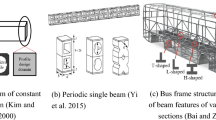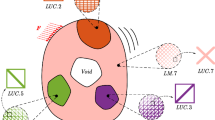Abstract
This paper examines the multi-objective morphology optimization of free-form cable-braced grid shells. First, according to the shape forming method for grid shells, shape optimization can be realized by adjusting the generatrix and directrix rather than optimizing the whole surface. Second, the multi-objective shape optimization of free-form cable-braced grid shells is conducted. According to different practical requirements, the mechanical and geometric indexes, mechanical and economic indexes, or different mechanical indexes are used as multiple optimization objectives. Four main conclusions can be drawn from this study. First, with the above shape optimization method, the optimized surface does not change significantly; therefore, this method is useful in the shape optimization of grid shells with given initial surfaces. Second, among the static mechanical performance indexes, the mechanical behavior of the cable-braced grid shell is better with strain energy as the optimization objective. Third, with the weight of steel tubes and strain energy as the optimization objectives, the result of the multi-objective optimization that combines section optimization with shape optimization is favorable and practical in engineering applications. Fourth, when strain energy and the variance of the tube lengths are used as multiple optimization objectives, the structural mechanical behavior is not sensitive to the weight factor of variance of the tube lengths.
Similar content being viewed by others
References
Chun, X. (2006). Multi-objective evolutionary algorithms and their applications. National Defence Industry Press, Peking, pp. 7–8.
Goldberg, D. E. (1989). Genetic Algorithms in search, Optimization and Machine Learning. Addison-Wesley, MA, pp. 22–41.
Feng, R., Ye, J., and Yao, B. (2012). “Evaluation of the buckling load of an elliptic paraboloid cable-braced grid shell using continuum analogy.” Journal of Engineering Mechanics, 138(12), pp. 1468–1478.
Feng, R., Yao, B., and Ye, J. (2013). “Stability of lamella cylinder cable-braced grid shells.” Journal of Constructional Steel Research, 88(9), pp. 220–230.
Feng, R., and Ge, J. (2013). “Shape optimization of freeform cable-braced grid shells based on the translational surfaces technique.” International Journal of Steel Structures, 13(3), pp. 435–444.
Jiang, D. and Zhang, Z. (2006). “A review on topology and layout optimization of truss structures.” Advances in Science and Technology of Water Resources, 26(2), pp. 81–86.
Schlaich, J. and Schober, H. (1997). “Glass roof for the Hippo House at the Berlin Zoo.” Structural Engineering International, 7(4), pp. 252–254.
Schlaich, J. and Schober, H. (1999). “Recent glass roofs.” Journal of the International Association for Shell and Spatial Structures, 40(3), pp. 193–205.
Glymph, J. and Shelden, D. (2004). “A parametric strategy for free-form glass structures using quadrilateral planar facets.” Automation in Construction, 13(2), pp. 187–202.
Kimuru, T., Ohmori, H., and Hamada, H. (2007). “Computational morphogenesis of free form shells considering both designer’s preference and structural rationality.” Proceedinsgs of IASS, pp. 360–368.
Deb, K. (2001). Multi-objective optimization using evolutionary algorithms. Wiley, Chichester, pp. 7–15.
Ehrgott, M. and Gandibleux, X. (2000). “A survey and annotated bibliograghy of multiobjective combinatorial optimization.” OR Spektrum, 22, pp. 425–460.
Ohmori, H. and Kimura, T. (2009). “Computational morphogenesis of free form shells.” Proceedings of IASS, pp. 560–568.
Winslow, P., Pellegrino, S., and Sharma, S. B. (2010). “Multi-objective optimization of free-form grid structures.” Structural and Multidisciplinary Optimization, 40(1-6), pp. 257–269.
San, B., Wu, Y., Wei, D., and Shen, S. (2008). “Multiobjective optimization of membrane structures.” China Civil Engineering Journal, 41(9), pp. 1–7.
Shi, F. Z. (1994). Computer-aided geometric design and non-uniform rational B-spline. Higher Education Press, Peking.
Xie, T., Chen, H. W., and Kang, L. (2003). “Evolutionary algorithms of multi-objective optimization problems.” Chinese Journal of Computers, 26(8), pp. 997–1003.
Author information
Authors and Affiliations
Corresponding author
Rights and permissions
About this article
Cite this article
Feng, Rq., Zhang, l. & Ge, Jm. Multi-objective morphology optimization of free-form cable-braced grid shells. Int J Steel Struct 15, 681–691 (2015). https://doi.org/10.1007/s13296-015-9014-6
Received:
Accepted:
Published:
Issue Date:
DOI: https://doi.org/10.1007/s13296-015-9014-6




